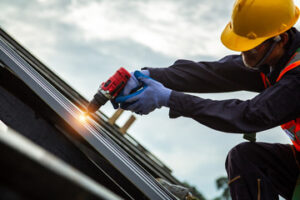A roof replacement, also known as reroofing, is a big project that involves tearing off the old roof, fixing the substrate, and installing new shingles. It’s an investment that can add value to your home and make it more energy efficient.

Clear toys and patio furniture to give roofing professionals a clear path around the house. This will help reduce the chance of them tripping or damaging items. Contact Boston Roofing CO for professional help.
Your roof is a complex structure, with many parts that intersect and join. Flashing is a crucial part of the roofing system that ensures water doesn’t leak into these crevices and cause internal damage to your home, like rot or mold growth. Flashing is narrow strips of impervious material, usually galvanized steel or aluminum. They are installed at points in the roof that have a higher risk of leaking, such as valleys where two different roof slopes meet. They are also placed around other structural aspects, such as chimneys, dormers and skylights.
The problem with flashing is that it’s exposed to the elements, which makes it susceptible to wear and tear, especially if your roof is in poor condition. Flashing can also be damaged due to poor installation by a roofing contractor. In some cases, the flashing may need to be replaced entirely if it’s old and worn out.
Some of the most common signs of flashing damage include rust, corrosion and cracks. These are signs that the flashing has been damaged and is no longer protecting the roof from water leaks. In addition, any holes in the flashing should be repaired immediately. Even the smallest holes can allow water to seep through and damage the interior of your roof.
If you suspect your flashing is damaged, it’s important to have a professional inspect the situation and repair or replace the flashing as needed. Since most flashing protrudes under the shingles, your roofing contractor will need to remove some of the shingles to access it. This can be a complicated procedure and should only be done by a skilled roofing professional.
In some cases, it may not be necessary to completely replace the flashing, especially if the damage is limited. In some situations, you can have the flashing resealed with silicone for a temporary fix. It’s important to note, though, that this can only be done if the flashing has not been damaged further by weather or other factors. If you suspect the flashing is damaged, have it replaced as soon as possible to avoid a costly roof replacement project in the future.
Missing Shingles
A roof is the first line of defense for your home, protecting it from the elements. If shingles are damaged or missing, your home is vulnerable to leaks and other issues. Missing shingles are an indicator that your roof needs a replacement, and it’s important to address these signs as soon as possible to avoid more costly repairs later.
A missing shingle opens your roof up to severe weather, heat, cold, debris, and moisture. Even a small patch of open shingle can allow water into your home, soaking insulation and wood beams and causing structural damage to your roof and your home.
The good news is that repairing missing shingles can be quite simple, especially if you have some do-it-yourself (DIY) skills and the right tools. If you can safely climb a ladder, you should start by counting the number of shingles that have blown off of your roof and surveying the surrounding area for additional damage. You can also loosen the shingles above any missing ones to inspect for hidden damage and remove partially damaged shingle granules that have already been blown off by the wind.
If you do have a few extra shingles lying around, you can simply cut one of them to the size of the hole in your roof and nail it into place. Be sure to use a fresh layer of roof sealant to keep the new shingle in place and prevent it from leaking or coming loose over time.
In most cases, however, it will be necessary to buy a bundle of shingles at a home center or lumberyard and install them yourself. Be sure to choose a type of shingle that matches the existing color and style of your roof to ensure a seamless repair.
If you aren’t comfortable climbing a ladder or performing your own roof repair, contact a local roofing company for help. A professional will provide a cost-effective, efficient, and comprehensive roof replacement service that keeps your Tampa or Sarasota home safe from weather damage and other threats. A reputable roofing contractor will also perform an inspection of your entire roof to ensure that the flashing and other components are functioning properly.
Leaking Roofs
When water leaks through the roof, it can do a lot of damage in a short amount of time. It can saturate insulation, stain ceilings, and darken and warp the attic floor and the drywall below it. It can also create a breeding ground for mold. If you have a leaking roof, it’s important to take action quickly.
Leaks often start in the valleys of your roof — the V-shaped areas where slopes meet. But they can also happen around vents, skylights, and chimneys. In many cases, the problem is with the flashing around those features — it’s either not properly installed or has become corroded and damaged over time.
Other common sources of leaks include damaged shingles or a shallow roof slope that allows water to collect in certain areas. This makes it hard for the roof to drain properly. And it can even lead to ice dams, which can damage and stain your roof and the inside of your home.
Aside from the obvious stains and water spots, a leaking roof can also cause ceilings to sag or bow. In some cases, the ceiling can become completely saturated with water, leading to mold growth and other problems.
Fortunately, it’s often possible to save your roof from extensive damage with a few repairs. But in some cases, a full replacement might be necessary. If your roof has sustained significant damage, it’s definitely worth getting a professional inspection to see what the best course of action is.
One of the first things you should do before a roofing contractor begins work is to protect your possessions from moisture damage. Move electronics, furniture, rugs, and other items from the area, and cover them with plastic or tarps. You should also clear out your attic or crawlspace before the roofing team arrives, and remove wall hangings that could fall and get damaged during the re-roofing process.
If your roof is leaking and you’re not sure what to do, it’s a good idea to contact a local roofing company right away. A professional can help you determine whether repair or replacement is the best option and give you an estimate for the cost of both options.
Uneven Roofs
Many homeowners find themselves dealing with uneven roofs. Whether the home in question is their own or one they’re considering purchasing, these wavy roofs can cause concern. Is the unevenness a result of an issue with the roof itself or something else? If the former, a roofing contractor can usually fix it. But if the latter, it’s a sign of a foundation problem that may require serious and costly structural work to correct.
Uneven roofs can be caused by a number of issues, including poor construction and old age. One common cause is a lack of proper ventilation. Insufficient air flow allows moisture to build up inside the layers of a house, leading to rotting and mold. This can lead to a sagging roof and other serious problems.
Other causes of uneven roofs include improper installation and warped roof sheathing. When a new roof is installed, the sheathing needs to be completely flat in order to provide a good base for the shingles. If the sheathing isn’t flat or is warped, the shingles will also appear uneven.
Another cause of an uneven roof is a problem with the underlayment, which is the layer of fabric-like material that lies beneath the shingles. It’s important to fully unroll and lay the underlayment before putting down the shingles. If the underlayment isn’t fully rolled or not properly placed, the shingles will look uneven with high spots and dips.
During a roof inspection, a qualified professional will look for these signs of unevenness. They’ll also inspect the foundation of a house and check for water stains, which can be a sign that the roof is leaking and causing damage to the walls or interior ceilings.
When you’re thinking about buying a property, it’s a good idea to schedule an inspection with a reputable roofer. A professional will be able to spot problems that you or the seller might miss and provide accurate estimates for repairs. During the inspection, a certified roofer will look at your landscaping, outdoor furniture and any decks you have to make sure they’re protected from damage during the project. They’ll also walk the roof to check for sagging or uneven roof lines and examine the condition of gutter systems.




